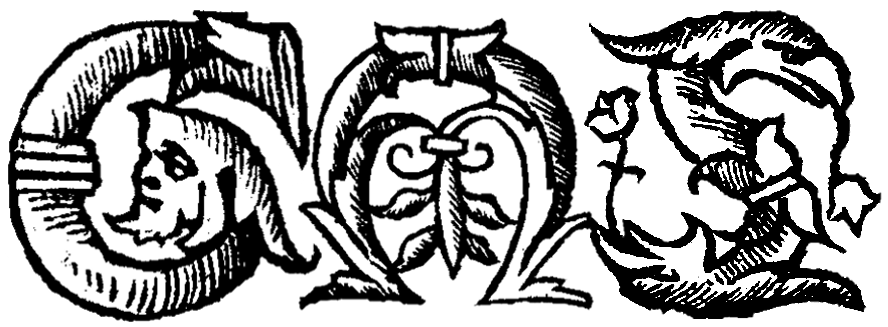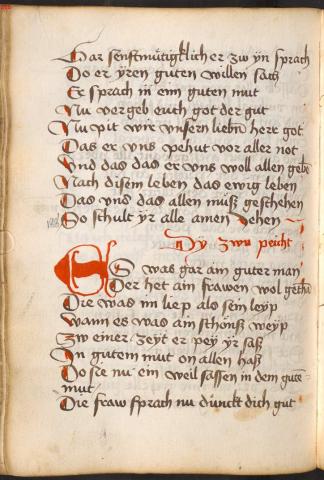The Two Confessions | Dÿ zwu peicht
Introduction to the Text
The Two Confessions (Dÿ zwu peicht) is an anonymously written story of which the oldest version dates from the second quarter of the 14th century. The manuscript on which this edition and translation are based was composed in the third quarter of the fifteenth century in the region of Northern Bavaria. The story belongs to the genre of “Märe”, i.e. stories handed down anonymously, shaped by literary conventions, aimed at entertainment and without any higher rhetorical, religious or critical claims.
Some context concerning religious practice is in order here. Confession is a sacrament most frequently associated with the Christian faith of Catholicism. In confession, the believer confesses their sins anonymously to a priest, who as an ordained representative of God has the authority to absolve sin and assign penance. In the late Middle Ages, the sacrament of confession worked somewhat differently than in modern Catholicism. It was not anonymous, took place less frequently, and there was a kind of “emergency provision” for confessing to a lay person (someone who is not clergy). It is also worth noting that in the Middle Ages, priests were always men.
The Two Confessions tells the story of a husband and wife who decide to confess their sins to one another. The wife initiates the process and is the first to confess; her husband’s question of whether she has had any other man leads her to confess to having slept with a total of twelve men in the village: the young shepherd, the lord’s messenger, the priest, the judge, the cellarer, the lord’s cook, the old shepherd, the neighbour’s son and three of his companions, and finally the sacristan. Against the husband’s complaints about her infidelity, the wife explains that each affair was to the advantage of their household: sleeping with the shepherd was in lieu of making the traditional small payment for services, the lord’s messenger will take them under his protection, the cellarer and the cook provide them with food and drink, and so on. Accepting his wife’s reasoning, the husband forgives her, and it is then his turn to confess. The husband confesses to having taken pleasure from touching their maid’s hand while they were on the field together. For this, the wife demands as penance that he cut off his hand and undertake a pilgrimage to Rome. She argues that her actions were borne out of wanting to provide for their household and good standing, whereas his indiscretion was purely out of lust for the maid. The husband pleads with his wife for mercy, until she instructs him to lead his life more truthfully going forward and then, assuming the role traditionally reserved for a male priest, uses Latin to absolve him of sin.
The modern reader may appreciate the entertaining and comical depiction of married life in the German Middle Ages through reading The Two Confessions. The story is quite literally a “he said, she said”: a man and a woman offer contradictory explanations of the same event with the reader being presented only with the spoken exchange and no kind of description. This simplistic yet direct style draws in readers, who might find themselves impressed by the extravagance of the wife’s confession and her subsequent furor at her husband having touched the maid’s hand. Gender, power, and the hierarchy of German society in the late Middle Ages all interrelate with each other in The Two Confessions.
Introduction to the Source
The Two Confessions survives in five manuscripts dating from the fourteenth to the mid-fifteenth century: Berlin, Staatsbibliothek Preuβischer Kulturbesitz, Ms. germ. oct. 1430 (B), Karlsruhe, Badische Landesbibliothek, Karlsruhe 408 (K), Donaueschingen 104, (Do), Vienna (Österreichische Nationalbibliothek, Cod. 3027 (W), and Munich, Bayerische Staatsbibliothek, cgm 714 (M), which is the text transcribed and translated here.
Because the versions of The Two Confessions in these five manuscripts differ to varying degrees from one another, scholars have divided them into two distinct groupings: Die zwei Beichten A (versions Do, K, W, and B) and Die zwei Beichten B (version M). Version M, the one presented here, is distinct in its setting, the role of the spouses, the number of lovers and the reason for the affairs. In Die Zwei Beichten A, the story is set at Easter. The couple is snowed in, preventing them from doing their yearly confession to a priest, which prompts the husband to suggest they confess to each other. This setting is absent in M, where the wife proposes the confession time while sitting at the fire. In M, the story ends with the wife taking on the role of the priest and, after a tongue-lashing, granting the husband absolution, whereas in the other versions the husband gets beaten with a broom. In some versions (Do and K), the story ends with a moral, either asking God to shame “false wives” (Do) or advising husbands not to ask questions of their wives that they don’t want to know the answer to (K). The number of lovers in M is high (12) as compared to Do (4) and K (5), but not as high as in version W (21). However, the motivation for having slept with them in M is only economical; in the other versions there are a variety of reasons besides economical gain: violence, lust, pity.
Die zwei Beichten is titled Dÿ zwu peicht and appears in cgm 714, on fol. 431r-441v, which is housed in the Bayerische Staatsbibliothek München (Bavarian State Library in Munich). With its 204 lines, it is one of the longer versions of this tale. The manuscript is dated to the third quarter of the 15th century and was written in Nordbairisch (a North-Bavarian variety of Middle High German) on paper. Cgm 714 is a compilation manuscript that contains rhymed couplet texts largely belonging to the genres of Minnerede (texts about love), Mären (comic tales) and Fastnachtsspiele (carnival plays).
About this Edition
The diplomatic transcription in this edition strives to retain the original manuscript’s structure by recording scribal corrections and deletions. Crossed out letters and words in the manuscript have been kept and are crossed out in this edition as well. Abbreviations are expanded, indicated by square brackets ([ ]), and insertions are indicated with angle brackets (< >). Variations of the different renderings of the letter “u”- (likely included to indicate different sounds) have been unified to the modern “u” spelling. The descending s (ſ) is replaced with the round s; the sz-spellings are kept, but again, the descending s (ſ) is replaced with the round s. The spacing between prefixes and word stems are inconsistent and are frequently seen in instances where the preface “ver” precedes a verb. The inconsistencies in word spacing have been faithfully transcribed throughout. No punctuation has been added in the transcription of the manuscript.
What is interesting in this manuscript are inclusions of discourse markers which are known in conversation analysis as words or phrases that play a role in managing the flow and structure of discourse. The discourse markers in this edition are the words: “joo” translated as “oh” and “eÿ” translated as “well”.
Further Reading
“Die zwei Beichten A.” Deutsche Versnovellistick des 13. bis 15. Jahrhunderts, edited by Klaus Ridder and Hans-Joachim Ziegeler, Schwabe Verlag, 2020, pp. 112–30.
Rasmussen, Ann Marie. “Gender und Subjektivität im Märe die zwei Beichten (A und B).” Inszenierungen von Subjektivität in der Literatur des Mittlealters, edited by Martin Baisch, Jutta Eming, Hendrikje Haufe, and Andrea Sieber, Ulrike Helmer Verlag, 2005, pp. 271–87.
Schröder, Werner. “Die zwei Beichten A und die zwei Beichten B.” Die deutsche Literatur des Mittelalters. Verfasserlexikon, 2nd ed., Verfasserlexikon 10. Berlin, 1977, pp. 1615–17.
Credits
Transcription by Margreet De Rooij, Eva Dirschka, Matthieu Martin, Elizabeth Milne, Nina Profazi, and Myrto ProvidaTranslation by Margreet De Rooij, Eva Dirschka, Matthieu Martin, Elizabeth Milne, Nina Profazi, and Myrto ProvidaIntroduction by Margreet De Rooij, Eva Dirschka, Matthieu Martin, Elizabeth Milne, Nina Profazi, and Myrto ProvidaEncoded in TEI P5 XML by Dante ZhuSuggested citation: Anonymous. "The Two Confessions." Trans. Margreet De Rooij, Eva Dirschka, Matthieu Martin, Elizabeth Milne, Nina Profazi, Myrto Provida. Global Medieval Sourcebook. http://sourcebook.stanford.edu/text/two-confessions. Retrieved on April 24, 2024.

